 |
|

|
 |
TABLE of CONTENTS
 |
Legislative sessions ends without passing major transportation bill |
By Erik Rudeen, Government Affairs

The 2016 legislative session wrapped up May 22. Photo by David Gonzalez |
The 2016 legislative session ended at midnight on May 22, with the Legislature failing to successfully pass major transportation and capital investment bills. Once it became clear that an agreement could not be reached on a long-term, comprehensive transportation funding package, the Legislature attempted to provide some one-time transportation funding as part of the capital investment bill. But with time running out, that bill failed to pass on the final night of session.
Several members of the Legislature and the public have asked Gov. Dayton to call a special session of the Legislature so that a capital investment bill can be enacted, but the governor has not decided whether to bring legislators back to St. Paul.
Several smaller transportation policy bills made it through the legislative process and have been signed into law, or likely will be soon. Those provisions include:
- Allowing special contracting authority for highways on tribal lands
- Providing enforcement authority for nonemergency medical transportation
- Authorizing specific service signs on two trunk highways
- Increasing weight limits for vehicles powered by natural gas
- Modifying the permitting process for manure pipelines on local roads
- Authorizing school bus flaggers to stop traffic
- Allowing pedicabs to have small electric power-assist motors
- Setting requirements for utilities that cross railroad rights of way
The Legislature also ratified state employee contracts, and passed a tax bill and a supplemental appropriations bill that provides additional funding for other state agencies. A full summary of the legislative session will be available on the Government Affairs ihub site within a few weeks. |
 |
|

|
 |
TABLE of CONTENTS
 |
Interstate 94 project to help reduce congestion east of St. Paul |
By Rich Kemp
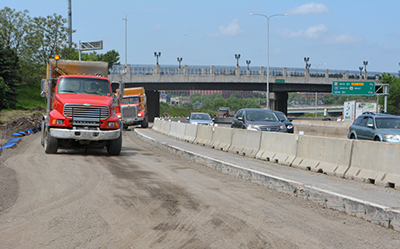
Crews work on an auxiliary lane May 24 along eastbound I-94 near Mounds Boulevard. Photo by Rich Kemp |
The Interstate 94 project is in full swing between East 7th Street in St. Paul and Hwy 120/Century Avenue in Maplewood. The project will run from spring 2016 through late fall 2017.
The project will resurface eastbound and westbound I-94 between Mounds Boulevard, to east of Hwy 120/Century Avenue. The project will also:
- Build a new auxiliary lane and extend the existing auxiliary lane along eastbound I-94 between the exit to East 7th Street and the entrance from Mounds Boulevard
- Construct two emergency pull-off sites along eastbound I-94 between the exit to East 7th Street and the entrance from Mounds Boulevard
- Resurface Hwy 61 from north of Burns Avenue to Hwy 5
- Create trail connections at McKnight Road and Century Avenue
- Update signals and pedestrian access
- Build a new noise wall and replace part of an existing noise wall between Conway and Maple streets
- Repair bridges
“To help reduce delays, crews will deploy several tactics, such as using moveable barriers to open lanes during peak times and placing signs with real-time delay information outside of work zones so motorists can choose to avoid the areas,” said Dale Gade, Metro North Area engineer.
This section of I-94 will be reduced to two lanes in each direction most the summer.
When completed, the project will help reduce congestion, provide a smoother ride, improve drainage and extend the service life of the roadway, bridges and drainage system.
The project manager is Marcell Walker. For more information on the project and to get updates, check out the project website. |
 |
|

|
 |
TABLE of CONTENTS
 |
Adopt a Highway group has been cleaning along Hwy 71 since 1990 |
The video follows a group of Adopt a Highway volunteers as they pick up trash along Hwy 71 near Willmar. Video produced by Rich Kemp |
|
 |
|

|
 |
TABLE of CONTENTS
 |
Statewide Freight System Plan nearing completion |
By Sue Roe
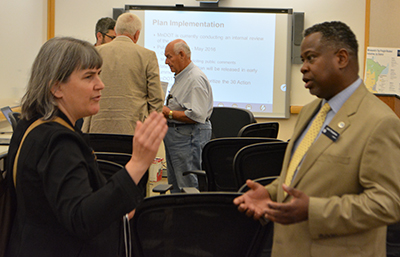
John Tompkins, freight office, talks with Cathy Velasquez Eberhart, Citizens Acting for Rail Safety, during a public hearing May 25 for the Statewide Freight System Plan. The plan will assess freight transportation issues and needs to ensure the state’s economic vitality. Photo by Marcia Lochner |
The Office of Freight and Commercial Vehicle Operations is finalizing the Statewide Freight System Plan in June. The plan will assess freight transportation issues and needs to ensure the state’s economic vitality.
A public meeting was held May 25 at Central Office to gather public input about the draft plan.
Interested persons can review the freight plan and provide feedback online. Deadline to submit comments is June 24.
John Tompkins, project manager, said the freight plan is an update to the 2005 plan.
“After more than 10 years, this plan continues to underscore the importance of a competitive and connected freight transportation system in the state,” said Tompkins.
With increased federal focus on freight through the Moving Ahead for Progress in the 21st Century, or MAP-21, and the recently passed Fixing America’s Surface Transportation or FAST Act, Tompkins said the updated plan will address today’s challenges and prepare Minnesota for the future.
Private companies and other public entities worked with MnDOT to identify industry and economic trends and freight transportation needs and issues. The plan provides a policy framework and strategies for MnDOT and other freight stakeholders to guide improvements to the multimodal freight system, which includes highway, rail, water and air.
The updated plan also includes a freight action agenda, with 30 strategies to preserve and strengthen the condition and performance of the state’s freight transportation system. The action agenda includes an investment plan and dedicated funding for freight projects.
Persons attending Wednesday’s meeting had the opportunity to prioritize the 30 strategies so MnDOT can identify freight initiatives and projects.
“The freight system helps drive Minnesota’s economy by moving goods within the state and to national and international markets,” said Bill Gardner, director of the Office of Freight and Commercial Vehicles Operations. “Businesses and the communities they operate in rely on a safe, efficient and reliable freight transportation system.”
Between now and 2040, annual freight tonnage in the state is expected to grow significantly and place greater stress on an already-congested system.
The freight plan aligns with the Statewide Rail Plan and the Statewide Ports and Waterways Plan.
Learn more about freight in Minnesota. |
 |
|

|
 |
TABLE of CONTENTS
 |
Five transportation research projects to improve environment |
|
By Micheal Foley, Research Services
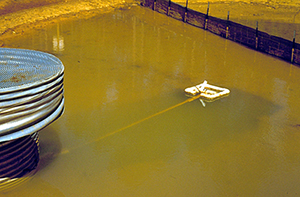
Temporary stormwater ponds with floating head skimmers can remove clean water from the surface of a settling pond. Photo courtesy of Research Services |
As Minnesotans get ready to head outdoors for Memorial Day, they can appreciate some of the work MnDOT is doing to help keep the state’s lakes and rivers clean.
Here’s a glance at five recent research projects that Minnesota transportation agencies are undertaking to improve the environment.
1: Reducing road construction pollution by skimming stormwater ponds
Soil carried away in stormwater runoff from road construction sites can pollute lakes and rivers.
Temporary stormwater-settling ponds provide a place for this sediment to settle before the water is discharged into local bodies of water. However, since stormwater ponds have limited space, a mechanism is needed to remove clean water from ponds to prevent the overflow of sediment-laden water.
MnDOT-funded researchers developed designs for temporary ponds that employ floating head skimmers to remove clean water from the surface of the settling pond, using gravity to discharge water into a ditch or receiving body.
The designs for these ponds are estimated to remove approximately 80 percent of suspended solids from stormwater runoff. They can help contractors meet federal requirements for stormwater pond dewatering. Learn more here.
MnDOT also evaluated treatments for purifying construction site runoff and determined how to better determine the impervious area of a watershed, which will enable more accurate stormwater modeling and cost-effective investments.
2: Roadside drainage ditches reduce pollution more than previously thought
Stormwater can pick up chemicals and sediments that pollute rivers and streams. Roadside drainage ditches, also known as swales, lessen this effect by absorbing water. But until recently, MnDOT didn’t know how to quantify this effect and incorporate it into pollution control mitigation measures.
In a study completed in fall 2014, researchers evaluated five Minnesota swales, measuring how well water flows through soil at up to 20 locations within each swale.
Research found that grassed swales are significantly better at absorbing water than expected, which may reduce the need for other, more expensive stormwater management practices, such as ponds or infiltration basins.
This could save MnDOT and counties significant right of way and construction costs currently expended on more expensive stormwater management techniques.
“There’s a big push in Minnesota, and probably everywhere, to do more infiltration. We know that our ditches are doing some of that, but we wanted to look at how much infiltration these ditches are providing,” said Barbara Loida, Metro District MS4 coordinator engineer.
3: Reducing road salt usage on local roads with permeable pavements
Road salt is used for de-icing roadways during winter months, but it can have a negative effect on the environment.
Some initial investigations suggest that road salt application can be substantially reduced, and perhaps even eliminated, for low-volume roads with permeable pavements. New research, funded by the Minnesota Local Road Research Board and administered by MnDOT, will investigate this hypothesis more thoroughly, and further document the reduction in road salt application that can be expected with permeable pavement.
Although they are too porous to durably support high-volume, high-load roadways, permeable pavements have been used successfully for parking lots and low-volume roads, like neighborhood streets, in some areas of the country.
“In Robbinsdale, permeable pavement reduced snow and ice without salt,” said John Gulliver, University of Minnesota researcher. “Permeable pavement is the only way that I know of to mitigate or to reduce our salt application, aside from everyone slowing down and putting up with less salt.”
4: Hwy 53 shows potential of using road construction excavation areas for wetland mitigation
Road construction in northeastern Minnesota often causes wetland effects that require expensive mitigation. However, borrow areas excavated for road construction material can be developed into wetland mitigation sites if hydric vegetation, hydric soils and adequate hydrology are provided. Fourteen such wetland mitigation sites were constructed north of Virginia, along the Hwy 53 reconstruction project corridor and evaluated by researchers. All but one of the sites consistently meet wetland hydrology criteria.
According to the research report published in March 2016, these sites show the potential for creating mitigation wetlands in abandoned borrow pits in conjunction with highway construction.
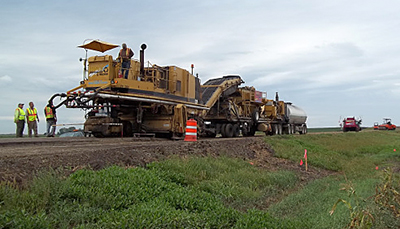
A cold in-place recycling equipment train in action. Photo courtesy of Research Services |
5: Recycling method could give third life to old concrete roads
MnDOT already extends the lives of some old concrete highways by paving over them with asphalt instead of tearing them up.
Now MnDOT hopes to add a third life for these old concrete roads by using a process called cold in-place recycling to re-use that asphalt pavement when it reaches the end of its life.
CIR uses existing pavements, without heat, to create a new layer of pavement. It involves the same process of cold-central plant mix recycling (which is MnDOT is using for the first time on two shoulder repair projects this year), but it is done on the road itself by a train of equipment. It literally recycles an old road while making a new road.
CIR has been in use in Minnesota for 20 years, but only with hot-mix asphalt over gravel roads. The purpose of a new study, recently approved for funding, is to validate Iowa’s promising new practice using CIR on bituminous over concrete.
In this research project, MnDOT will use cold in-place recycling to replace the asphalt pavement on a concrete road and then evaluate it for several years, comparing it also with control sections.
Along with the potential of a better service life, the cost of CIR is much lower than new hot mix asphalt. Therefore, a 20 percent to 30 percent price reduction per project may be realized.
|
 |
|

|
 |
TABLE of CONTENTS
 |
Contract management application achieves major production milestone |
By Betsy Parker, Chief Counsel and CAATS project champion
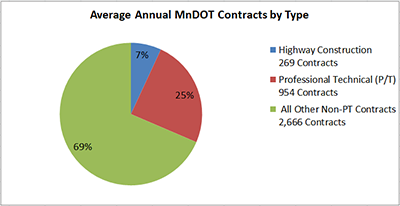
The chart reflects the average annual contracts by type based upon the number of contracts processed in FY 2014 and FY 2015 by the Contract Management Section within the Chief Counsel’s Office. |
Over the past 18 months, the project team for the Contracts Agreements Auditing Tracking System has developed a new contract management application. This application will be used for recording, tracking and reporting on the 3,000 to 4,000 contracts MnDOT administers annually.
“This is a great improvement that will improve transparency in the contract process and allow us to provide a higher level of service to our customers,” said Jim Cownie, assistant chief counsel for Construction and Contract Management.
The CAATS project is the beginning of a long-term, strategic approach to how MnDOT manages contracts and contract data. The initial release of the CAATS application, in February 2015, automated the assignment of contract numbers, replacing a manual process. The CAATS 3.0.0 production release provides the framework to manage data on all contracts. It provides full functionality to track all professional/technical contracts throughout their entire life cycle from posting an RFP, encumbering funds, obtaining contract signatures, paying invoices and tracking amendments, through final closeout and final audit.
The CAATS 3.0.0 production release replaces the functionality formerly provided by four separate systems - the Contract Management Application, the External Audit Tracking System, the Consultant Agreements Reporting and Tracking Application and the Metro Contracts Application. CAATS will be the MnDOT system of record for contracts, agreements and associated documents throughout the life cycle of the contract, with the exception of highway construction contracts administered by the Office of Construction & Innovative Contracting.
“I am very excited to see CAATS go into production,” said Dawn Thompson, Consultant Services assistant director. “CAATS was created by taking the best from CART and adding items many of us have wanted for years. To improve service to our customers CAATS enhancements include more workflows, electronic signatures, real-time contract data and an automated consultant evaluation process. It has been a good experience working with the CAATS team and supporting the mission to develop a long-term, strategic approach to how the department manages its contracts.”
Benefits to MnDOT:
- Reduces redundant data in multiple legacy systems
- Interfaces with SWIFT data through the MnDOT warehouse
- Automates a number of work flow processes including contract certification forms, contract signatures and invoice approvals
- Includes the ability to track real-time approval dates using electronic signatures
- Allows easy access to all contract-related documents stored in eDOCs accessible via one contract management application
- Provides confidence that contracts comply with legal obligations and are managed and reported from a single source accurately and consistently
Over the next year, from June 2016 to June 2017, the CAATS project team will work on Phase II to leverage the functionality and framework developed in Phase I for non-professional technical MnDOT contracts.
Key Dates
- May 24, 2016 - CART, CMA, EATS and MCA applications are retired
- May 25, 2016 - CAATS 3.0.0 production release date
To optimize the CAATS experience, a modern browser is recommended. The latest version of Google Chrome is needed. Open a ticket with the *DOT_ITServiceDesk to have Google Chrome installed.
All MnDOT employees with an active directory account will have viewing rights in CAATS.
For more information about the CAATS application, visit http://ihub/caats/. |
 |
|

|
|

|
 |
TABLE of CONTENTS
 |
Employees celebrate Global Accessibility Awareness Day |
By Greg Ruhland
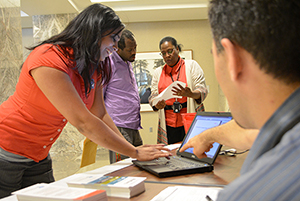
In the foreground, Greg Ruhland shows Cindy Charles how to take the “no-mouse challenge” by navigating a PDF using only keyboard shortcuts. Photo by Rich Kemp |
MnDOT employees celebrated the fifth Global Accessibility Awareness Day May 19, sponsored by the MN.IT Office of Accessibility.
Tip sheets and other accessibility handouts were passed out at district offices, the Central Office lobby and Waters Edge conference room to help get people thinking and talking about digital accessibility (web, software, mobile) and users with various disabilities.
If you would like more information, take the “no mouse challenge” or contact the Communications web team to request additional accessibility tip cards. |
 |
|

|
|

|
 |
TABLE of CONTENTS
 |
What’s new on the web |
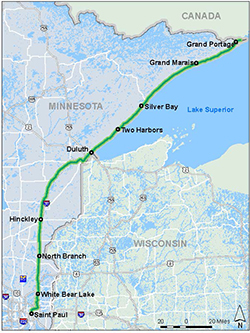
U.S. Bicycle Route 41 will be approximately 325 miles long and connect with the state’s first designated U.S. bicycle route, the Mississippi River Trail. |
Complete Streets
The Complete Streets policy has been published. The revised policy includes guidance for capital programming priorities, preservation projects and project documentation. Information in Technical Memo 14-08-TS-02 has been included in the policy update and the technical memo was retired. Policy was updated and approved May 2016.
U.S. Bicycle Route 41
The U.S. Bicycle Route 41 web page is now available at www.dot.state.mn.us/bike/usbr41/. This page tells about the new state’s U.S. Bicycle Route and how workshops in June will help determine and name the route. The route will run from St. Paul to Grand Portage State Park. You can also take online surveys to help the bicycle section decide which roads and trails are best for bicycling.
New Library Materials
New Library Materials are available at www.mndot.gov/library/newlibmat.html. This issue features the new digital-only AASHTO publication “Standard Specifications for Transportation Materials and Methods of Sampling and Testing.”
New Library Materials is a compilation of new titles and other resources added to the library collection during the previous month. If you would like to be added to the distribution list, contact Pam Gonzalez at 651-366-3749.
Previous editions of New Library Materials are available at www.mndot.gov/library/recacq-archive.html.
For other information requests, contact the Library at 651-366-3791 or email library.dot@state.mn.us, or send requests via the Ask a Librarian Web page at www.mndot.gov/library/asklibrarian.html.
New video on Ombudsman Office website
This video explains the Ombudsman Office and the services it provides. Video produced by Gary Andrist |
|
 |
|
| |
|



